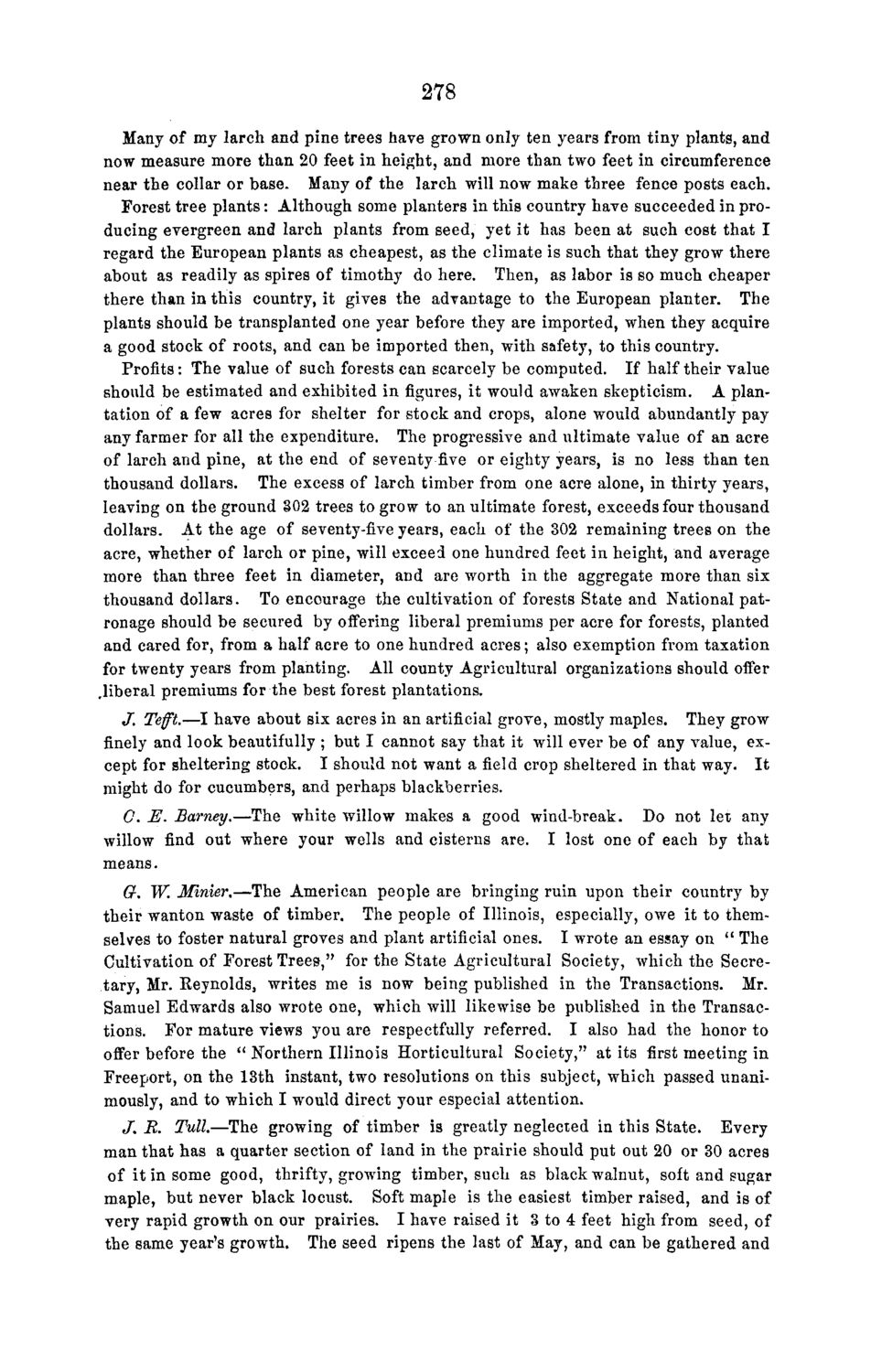| |
| |
Caption: Board of Trustees Minutes - 1868
This is a reduced-resolution page image for fast online browsing.

EXTRACTED TEXT FROM PAGE:
278 Many of my larch and pine trees have grown only ten years from tiny plants, and now measure more than 20 feet in height, and more than two feet in circumference near the collar or base. Many of the larch will now make three fence posts each. Forest tree plants: Although some planters in this country have succeeded in producing evergreen and larch plants from seed, yet it has been at such cost that I regard the European plants as cheapest, as the climate is such that they grow there about as readily as spires of timothy do here. Then, as labor is so much cheaper there than in this country, it gives the advantage to the European planter. The plants should be transplanted one year before they are imported, when they acquire a good stock of roots, and can be imported then, with safety, to this country. Profits: The value of such forests can scarcely be computed. If half their value should be estimated and exhibited in figures, it would awaken skepticism. A plantation of a few acres for shelter for stock and crops, alone would abundantly pay any farmer for all the expenditure. The progressive and ultimate value of an acre of larch and pine, at the end of seventy five or eighty years, is no less than ten thousand dollars. The excess of larch timber from one acre alone, in thirty years, leaving on the ground 302 trees to grow to an ultimate forest, exceeds four thousand dollars. At the age of seventy-five years, each of the 302 remaining trees on the acre, whether of larch or pine, will exceed one hundred feet in height, and average more than three feet in diameter, and are worth in the aggregate more than six thousand dollars. To encourage the cultivation of forests State and National patronage should be secured by offering liberal premiums per acre for forests, planted and cared for, from a half acre to one hundred acres; also exemption from taxation for twenty years from planting. All county Agricultural organizations should offer .liberal premiums for the best forest plantations. J. Tefft.—I have about six acres in an artificial grove, mostly maples. They grow finely and look beautifully ; but I cannot say that it will ever be of any value, except for sheltering stock. I should not want a field crop sheltered in that way. It might do for cucumbers, and perhaps blackberries. 0. E. Barney.—The white willow makes a good wind-break. Do not let any willow find out where your wells and cisterns are. I lost one of each by that means. G. W. Minier.—The American people are bringing ruin upon their country by their wanton waste of timber. The people of Illinois, especially, owe it to themselves to foster natural groves and plant artificial ones. I wrote an essay on " The Cultivation of Forest Trees," for the State Agricultural Society, which the Secretary, Mr. Reynolds, writes me is now being published in the Transactions. Mr. Samuel Edwards also wrote one, which will likewise be published in the Transactions. For mature views you are respectfully referred. I also had the honor to offer before the " Northern Illinois Horticultural Society," at its first meeting in Freeport, on the 13th instant, two resolutions on this subject, which passed unanimously, and to which I would direct your especial attention. J". E. Tull.—The growing of timber is greatly neglected in this State. Every man that has a quarter section of land in the prairie should put out 20 or 30 acres of it in some good, thrifty, growing timber, such as black walnut, soft and sugar maple, but never black locust. Soft maple is the easiest timber raised, and is of very rapid growth on our prairies. I have raised it 3 to 4 feet high from seed, of the same year's growth. The seed ripens the last of May, and can be gathered and
| |